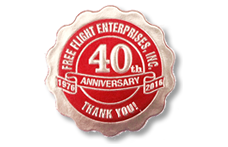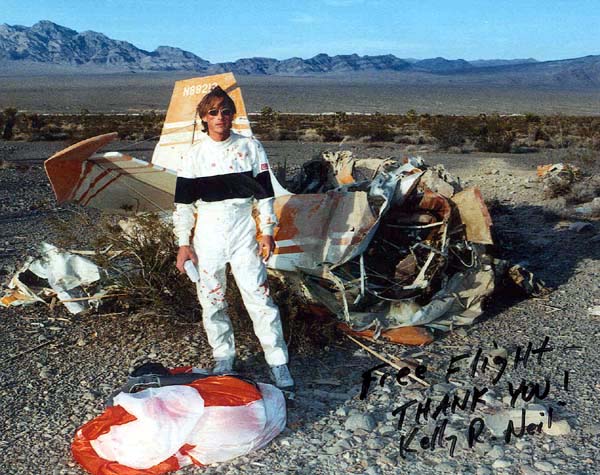
It Could Happen To You

It was a beautiful When I arrived at the airport on the afternoon of April 10th 1999, I was ready to fly. I had just finished a shift as a Crime Scene Analyst for the Las Vegas Metropolitan Police Department. It was a beautiful Saturday and work had been reasonably slow all day, giving me time to ponder the flight I had scheduled for 1500 hrs.. I drove to the hangar and picked up my helmet and parachute and then proceeded to the opposite end of the airfield to the shade hangar where a Citabria 7KCAB was awaiting my arrival. I had logged about 40 hrs. in this plane in the last two years and felt like I knew the aircraft like a good buddy. I had felt some sadness recently because the overhaul on my Acrosport I was nearing completion and I would probably not fly the Citabria much once my baby was finished.
The pre-flight was as uneventful as it had been the previous 40 or so times before and one of the last items on the list was to remove the seat cushions (they have a tendency to float off in negative maneuvers, in case you were wondering) and tie up the rear seatbelts to eliminate the possibility of control interference. After donning my parachute and helmet, I cinched into the front seat and fired the engine. I was cleared to taxi and after an uneventful run-up, cleared for departure on runway 07. I still get a little bit exited at this point because I am actually flying now and nothing else really matters for the next hour or so, usually.
As I approached the area where I practice I did the usual roll-to-inverted, back to straight-and-level, and re-tightened my belts. I practice at about 6000 ft. MSL (3300 AGL)and have always felt that was a sufficient cushion for any situation I might find myself in (please note my revised opinion later in this article.) The first 30 minutes of the flight consisted of the usual combination of loops, rolls, hammerheads, etc..., and I felt like I was ready to head out and practice in the box. Well, maybe one last spin to burn some altitude so I could stay under class B airspace on the way to the box.
Throttle back to the stop, nose slightly above our uneven Las Vegas horizon, airspeed dwindling, stick full back/left rudder, shot of power for a clean break,... "one-half, one, one-and-a-half, (right rudder), two, forward stick...uh hum, guess you didn’t hear me, I said forward stick, *@!*#!!!. In retrospect, I am reminded of a dream where you are trying to escape some evil villain only to find that your legs won’t work. That is my best explanation of how I felt at that moment. Now the reality is obvious, do something quickly or die.
The next few seconds were busy as I remember it. Trying to look into the back seat to check the rear stick is a difficult task when you are securely fastened to the front seat, facing the wrong way, however, my flexibility surprised me and I saw that the rear seatback was in a really crummy configuration, looped over the rear stick below the second rung of the seat back. Again *@!*#!!!. I tried in vain to knock the seat loose and in approximately the same time frame applied full forward trim. No luck on either effort. Time to bail!
I always had vision of what would happen if I ever had to jettison the door, but apparently someone changed the script and failed to notify me because the scene was not at all what I had rehearsed. Pull the pin, rotate the red handle, door is gone, oops, no, door is still here, improvisation time, whack door with elbow, nope, whack door with shoulder, nope, unfasten seatbelt and lunge at door like a linebacker, much better. I should mention that somewhere during this last segment the plane broke into a right spin and I had also cut my fingers and was bleeding on everything in sight. Anyway, my helmet unplugged itself during the lunge ( I recommend this feature if you are planning to buy a helmet, which you should) and I was out the door. Considering the spin and the fact that my only actual parachute experience was a tandem jump with my girlfriend about 6 months previous, I was pretty stable. I looked for my D-ring, grabbed it firmly and pulled..... I would like to thank God, Allen Silver, Para-Phernalia Inc., Free Flight and Jim Abraham, I think they know why without explanation, and you will just have to figure it out.
*@!*#!!!, that hurt, but it really felt good! That is the only way I can describe the chute opening. I dropped my D-ring, grabbed the steering handles and looked down just in time to see the airplane that had taken care of me so well for so many flights hit the ground in a right spin and bounce laterally about 50 feet. I landed about 15 seconds later. Surveying the damage I determined that my only obvious injuries were lacerations on two fingers and a scrape on my right eyebrow and chin(Later that night and next day many bruises popped up in areas beneath the parachute straps, I will leave it up to you to imagine where exactly these might be.)
So why did I feel compelled to tell you about all of this? Well, two reasons I guess. First, I have to admit that as it turned out, the bail-out was somewhat exciting and everyone likes to tell a good war story. More importantly though, as corny as it may sound, this could happen to you, and you need to be ready. I never expected to have use my parachute in this way. I never thought I would use my helmet as a battering ram to knock loose a jammed door, but in those seconds everything that I had heard from Allen Silver, all the safety tips that Jim Abraham and other aerobatic pilots have drilled into my head, and having a good chute and helmet gave me a level of confidence and preparedness that I needed to do what I had to do to save my life. If I had been wearing my Nomex gloves as I usually do I probably wouldn’t have even cut my fingers.
I know we all think about safety and may even get a little tired of all of the harping about it, but I can tell you that in a jam is no time to try to figure out what you should do. Avail yourself of every bit of information you can get your hands on, go to seminars, preach to your friends, get and maintain good equipment,... oh, and my revised "practice altitude" opinion is as follows: Practice at least 1000 ft. higher than I ever think I will need. Have fun and fly safe!
Kelly R. Neil
